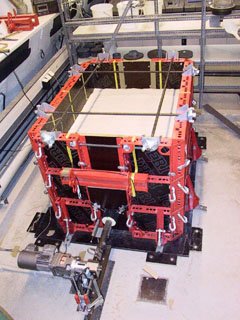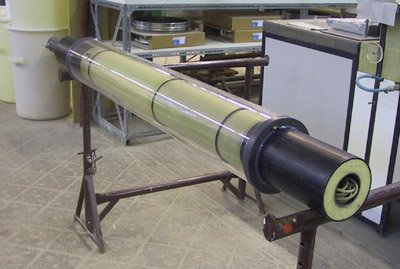Soil-pipeline interaction
Prof. Dr.-Ing. Martin Achmus / Dr.-Ing. Ingo Weidlich
Introduction
Nowadays, in most cases district heating pipelines are buried in the underground. The displacement of buried district heating pipes due to internal pressure and temperature changes of the transported medium leads to intensive interaction with the surrounding soil. Changes in length and diameter of the internal steel pipe are inevitable. It is well known from experimental investigations that the friction force acting on a district heating pipeline is not constant, but is dependent on the operating temperature, i.e. the temperature of the heat-transporting medium. Two phenomena should be mentioned here:
- Friction forces increase with increasing operating temperature
- Maximum friction force decreases with cyclic unloading and reloading
To get a better insight in the process, the effects had to be studied separately. Because a model for the determination of the friction force increase due to radial expansion was already presented by Achmus (1995), this investigation focuses on friction reduction due to axial cyclic loading and unloading.
Experimental set-up



A special experimental set-up was designed to investigate the reduction of friction forces under laboratory conditions. The experimental set-up consists of a sand box with a cross section of 90 cm x 90 cm (width x height) and a length of 120 cm (Fig. 1). In this box HDPE-coated district heating pipes (DN 40, DN 65 or DN 80) were placed and embedded in dry homogeneous sand. The pipe sections had lengths of about 150 cm. Cyclic axial displacement of the pipe section was carried out by means of an electrical push-pull device.
Measurement



The force necessary to push or pull the pipe was measured by a 10 kN loading cell outside of the sandbox. Five displacement sensors were installed. One was used to measure the axial displacement and four (two at both ends of the pipe) to observe pipe settlements. A grid- based tactile pressure sensor , an innovative measurement technology, was used in some tests also.
The data logger unit and the cable were placed inside the pipe to avoid disturbance of the stress state. In order to do that, a part of the pipe was cut out and replaced after installation. Subsequently, a PE foil was wrapped around the sensor foil to protect it from damage by the shear stresses occurring during axial pipe displacement. The calibration of the pressure sensor had to be carried out after installation and was thus a difficult procedure. Different constant and uniform pressures had to be applied to determine the calibration parameters. For this purpose, a special calibration set-up was designed (Fig.2).
Results



As a measure for the friction force decrease, a degradation factor DF=Fi/F0 was defined. The DF-values determined in about 60 tests with dense sand (Dr = 0.7) and different overburden heights and pipe diameters are presented here. A clear tendency of increasing DF-values with increasing relative overburden height is found. Equation 1 was obtained by a linear regression analysis.



Results of the pressure sensor measurements are shown in Fig. 3. In the left figure, the stress distribution after placement of the sand fill and before the begin of the test is shown. The primary or initial stress distribution is characterized by the typical concentration of pressures at the top and the bottom of the pipe, which has been expected. During the cyclic displacement, the contact stresses between soil and pipe decrease, whereby a much stronger decrease occurs in the regions where initially higher pressures were applied. Thus, after 10 cycles, an approximately constant and uniformly distributed residual stress around the pipe was measured (right figure).
Based on the experimental test data it is concluded, that
- relative density of the soil embedment and
- relative height of cover (H/D)
are important factors for the problem described.
The friction forces strongly influence the behaviour of and the stresses on district heating pipelines and should thus be determined as accurately as possible. In that respect, additional research is desirable.
Publications
[Translate to Englisch:] [1] I. Weidlich, M. Achmus, Reduction of friction forces between soil and buried district heating pipes due to cyclic axial displacements, 10th International Symposium on District Heating and Cooling, German Heat and Power Association AGFW, Hannover, 2006
[2] I. Weidlich, M. Achmus, Numerische Untersuchung der axialen Interaktion zwischen Fernwärmeleitungen und Boden, 19. Deutschsprachige Abaqus - Benutzerkonferenz, Baden - Baden, 2007
[3] I. Weidlich, Untersuchung zur Reibung an zyklisch axial verschobenen erdverlegten Rohren, Promotionsschrift, Mitteilungsheft 64 am Institut für Grundbau, Bodenmechanik und Energiewasserbau der Leibniz Universität Hannover, 2008
[4] I. Weidlich, M. Achmus, Measurement of Normal Pressures and Friction Forces Acting on Buried Pipes Subjected to Cyclic Axial Displacements in Laboratory Experiments, Geotechnical Testing Journal, Vol. 31, No. 4, pp. 334-343, 2008
[5] I. Weidlich, M. Achmus, Numerical Investigation on the axial Interaction between buried District Heating Pipes and Soil, The 11th International Symposium on District Heating and Cooling, Reykjavik, Iceland, 2008
[6] I. Weidlich, Untersuchung zur Größe der Reibungskräfte zwischen Fernwärmeleitungen und Boden, 30. Baugrundtagung der Deutschen Gesellschaft für Geotechnik (DGGT) in Dortmund, Spezialsitzung "Forum für junge Geotechnik-Ingenieure", 2008
[7] I. Weidlich, M. Achmus, Zur Reibung an erdverlegten Fernwärmeleitungen, Euroheat & Power, Heft 11, 37. Jg., S. 38 bis 42, 2008














